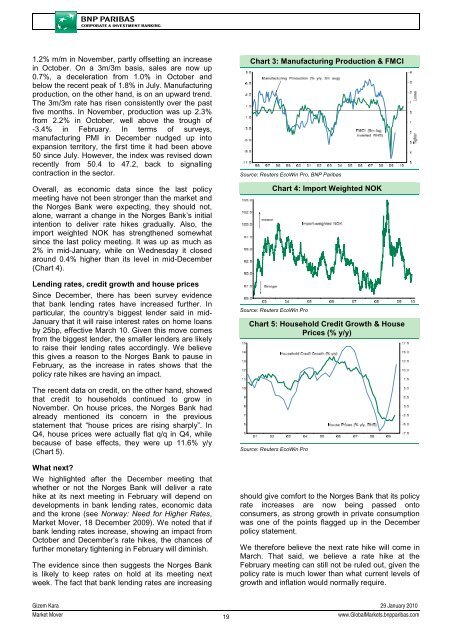Market Outlook - BNP PARIBAS - Investment Services India
Market Outlook - BNP PARIBAS - Investment Services India
Market Outlook - BNP PARIBAS - Investment Services India
You also want an ePaper? Increase the reach of your titles
YUMPU automatically turns print PDFs into web optimized ePapers that Google loves.
1.2% m/m in November, partly offsetting an increase<br />
in October. On a 3m/3m basis, sales are now up<br />
0.7%, a deceleration from 1.0% in October and<br />
below the recent peak of 1.8% in July. Manufacturing<br />
production, on the other hand, is on an upward trend.<br />
The 3m/3m rate has risen consistently over the past<br />
five months. In November, production was up 2.3%<br />
from 2.2% in October, well above the trough of<br />
-3.4% in February. In terms of surveys,<br />
manufacturing PMI in December nudged up into<br />
expansion territory, the first time it had been above<br />
50 since July. However, the index was revised down<br />
recently from 50.4 to 47.2, back to signalling<br />
contraction in the sector.<br />
Overall, as economic data since the last policy<br />
meeting have not been stronger than the market and<br />
the Norges Bank were expecting, they should not,<br />
alone, warrant a change in the Norges Bank’s initial<br />
intention to deliver rate hikes gradually. Also, the<br />
import weighted NOK has strengthened somewhat<br />
since the last policy meeting. It was up as much as<br />
2% in mid-January, while on Wednesday it closed<br />
around 0.4% higher than its level in mid-December<br />
(Chart 4).<br />
Lending rates, credit growth and house prices<br />
Since December, there has been survey evidence<br />
that bank lending rates have increased further. In<br />
particular, the country’s biggest lender said in mid-<br />
January that it will raise interest rates on home loans<br />
by 25bp, effective March 10. Given this move comes<br />
from the biggest lender, the smaller lenders are likely<br />
to raise their lending rates accordingly. We believe<br />
this gives a reason to the Norges Bank to pause in<br />
February, as the increase in rates shows that the<br />
policy rate hikes are having an impact.<br />
The recent data on credit, on the other hand, showed<br />
that credit to households continued to grow in<br />
November. On house prices, the Norges Bank had<br />
already mentioned its concern in the previous<br />
statement that “house prices are rising sharply”. In<br />
Q4, house prices were actually flat q/q in Q4, while<br />
because of base effects, they were up 11.6% y/y<br />
(Chart 5).<br />
What next?<br />
We highlighted after the December meeting that<br />
whether or not the Norges Bank will deliver a rate<br />
hike at its next meeting in February will depend on<br />
developments in bank lending rates, economic data<br />
and the krone (see Norway: Need for Higher Rates,<br />
<strong>Market</strong> Mover, 18 December 2009). We noted that if<br />
bank lending rates increase, showing an impact from<br />
October and December’s rate hikes, the chances of<br />
further monetary tightening in February will diminish.<br />
The evidence since then suggests the Norges Bank<br />
is likely to keep rates on hold at its meeting next<br />
week. The fact that bank lending rates are increasing<br />
Chart 3: Manufacturing Production & FMCI<br />
Source: Reuters EcoWin Pro, <strong>BNP</strong> Paribas<br />
Chart 4: Import Weighted NOK<br />
Source: Reuters EcoWin Pro<br />
Chart 5: Household Credit Growth & House<br />
Prices (% y/y)<br />
Source: Reuters EcoWin Pro<br />
should give comfort to the Norges Bank that its policy<br />
rate increases are now being passed onto<br />
consumers, as strong growth in private consumption<br />
was one of the points flagged up in the December<br />
policy statement.<br />
We therefore believe the next rate hike will come in<br />
March. That said, we believe a rate hike at the<br />
February meeting can still not be ruled out, given the<br />
policy rate is much lower than what current levels of<br />
growth and inflation would normally require.<br />
Gizem Kara 29 January 2010<br />
<strong>Market</strong> Mover<br />
19<br />
www.Global<strong>Market</strong>s.bnpparibas.com
















